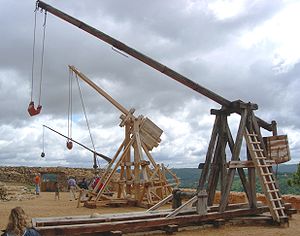

A trebuchet[nb 1] (French: trébuchet) is a type of catapult[5] that uses a rotating arm with a sling attached to the tip to launch a projectile. It was a common powerful siege engine until the advent of gunpowder. The design of a trebuchet allows it to launch projectiles of greater weights and further distances than that of a traditional catapult.
There are two main types of trebuchet. The first is the traction trebuchet, or mangonel, which uses manpower to swing the arm. It first appeared in China by the 4th century BC. It spread westward, possibly by the Avars, and was adopted by the Byzantines, Persians, Arabs, and other neighboring peoples by the sixth to seventh centuries AD.[6][7][8]
The later, and often larger and more powerful, counterweight trebuchet, also known as the counterpoise trebuchet, uses a counterweight to swing the arm. It appeared in both Christian and Muslim lands around the Mediterranean in the 12th century, and was carried back to China by the Mongols in the 13th century.[9]
- ^ Fulton 2018, p. 425.
- ^ Needham 1994, p. 236.
- ^ OED, Random House Unabridged Dictionary
- ^ Random House Unabridged Dictionary
- ^ Janin 2014, p. 41.
- ^ Cite error: The named reference
PAULwas invoked but never defined (see the help page). - ^ Graff 2016, p. 142 "Another, more specifically Chinese contribution to military technology that may have been carried westward by the Avars is the traction trebuchet. In contrast to the counterweighted trebuchet..."
- ^ Cite error: The named reference
purton 2009 33was invoked but never defined (see the help page). - ^ Fulton 2016, pp. 4–5 "Although this is strong evidence that this type of technology was known, and likely employed, in the Levant before the first known use of ‘trebuchet’, there is little consensus among scholars as to when and where the counterweight trebuchet was first developed. Al-Tarsusi’s description and accompanying illustration are far from conclusive proof that this type of engine was developed in the Islamic world. At the siege of Acre in 1189-91, eyewitness sources provide no indication that the artillery employed by either the Muslim garrison or the crusaders was superior."
Cite error: There are <ref group=nb> tags on this page, but the references will not show without a {{reflist|group=nb}} template (see the help page).